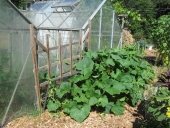posted 8 years ago
Several issues here. Like most GH's you're getting too much heat in the summer and not enough in the winter. Venting excess heat in the summer is the typical solution and you will likely need some regardless of what heat storing solution you put in. Putting shade cloth over the GH to cut down on sunlight and heat during the summer is another common solution, as is taking out panels and/or leaving doors open in the summer. Venting can be a DC fan which runs on a small PV panel if you don't have access to AC power too, or vents which open with heat sensitive actuators. You can also look into storing the excess for nights and cold days. Barrels of water is one way, but it tends to use up precious GH space. You can look into SHCS, which store heat in the soil under the GH. The SCHS might work well if you are planning on moving the GH to a new location, since it requires burying tubes in the ground under the GH. Be aware that in most cold climates, it is not possible to store enough excess summer heat to get thru the entire winter.
For the colder months, you probably will face the opposite issue, how to keep heat around longer. You may want to look at an inner liner in the GH to help with losses thru the glass. And insulating the foundation and/or soil under the GH will also help. Auxiliary heat is an option too, but can get quite expensive and/or time consuming if you are doing it manually.
I am not familiar with your climate, so can't really speak to what might be possible or not for a GH there, but you should be able to get the figures for solar radiation in the various months, degree days of heating, etc and calculate how much heat loss you will experience at various outside temps, and how much heat you'd have to add/store to keep the GH at some temp you desire for your plants (if you are planning on using it over the winter). Elliot Coleman's book on winter vegie growing talks a lot about how to manage a GH for winter production with little or no energy inputs.
It is a doable project, making small GH's usable. Not necessarily all 12 months of the year everywhere and not necessarily without some types of additional heat or storage in some places. But even with these limitations, a GH can add significantly to your ability to grow plants.







